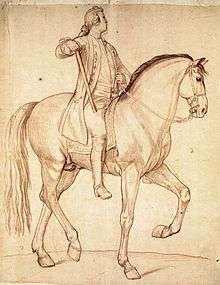Edmé Bouchardon
| Edmé Bouchardon | |
|---|---|
 Portrait of Bouchardon by François-Hubert Drouais in 1758. | |
| Born |
Edmé Bouchardon 29 May 1698 Chaumont-en-Bassigny, France |
| Died |
27 July 1762 (aged 64) Paris, France |
| Nationality | French |
| Known for | Sculpture |
| Notable work | Fontaine des Quatre-Saisons |
Edmé Bouchardon (29 May 1698 – 27 July 1762) was a French sculptor esteemed and valued as well as a painter and draughtsman.[1]
Biography
A native of Chaumont-en-Bassigny, Bouchardon was the son of sculptor and architect, Jean-Baptiste Bouchardon. He became the pupil of sculptor Guillaume Coustou and was awarded the Prix de Rome in 1722. Resisting the rococo tendencies of his contemporaries, he was classical in style. The noted antiquarian Comte de Caylus said of Bouchardon that he had begun "to appropriate for himself the talent of the Ancients and find it again in Nature." During the ten years he remained in Rome, Bouchardon was given the task of creating the bust of Pope Benedict XIII.
In 1746, Bouchardon produced his first acclaimed masterpiece, "Cupid Fashioning a Bow out of the Club of Hercules," now in the Louvre Museum,[2] which struck early viewers as shockingly crude in its unideal naturalism. His other masterpiece is the Fontaine des Quatre-Saisons in Paris, commissioned in 1739, and completed six years later in 1745. Bouchardon was commissioned to design an equestrian statue of Louis XV, to commemorate France's victory in the War of Austrian Succession. Unfortunately, he did not live to finish this work and its completion was left his contemporary Jean-Baptiste Pigalle. Ultimately, the statue was destroyed during the French Revolution.
Bouchardon was a well-known designer of jetons or tokens/medals, which were distributed by the King. The subjects and themes were chosen by the Académie des Inscriptions et Belles-Lettres and passed through an elaborate process of critiques before approval, which involved the King himself. Drawings and counterproofs for these jetons are now held at various museums and collections around the world including the Institut de France, the Musée de la Monnaie, and the Bibliothèque nationale.
Personal life
Bouchardon's brother, Jacques-Philippe Bouchardon, was also a sculptor, who became first sculptor to the king of Sweden.
Gallery
 Amor Fashioning a Bow after the Club of Hercules, 1750, Louvre Museum
Amor Fashioning a Bow after the Club of Hercules, 1750, Louvre Museum Genius of Abundance, 1731; Bode Museum
Genius of Abundance, 1731; Bode Museum Study for the Equestrian Statue of Louis XV, c. 1750; Louvre Museum
Study for the Equestrian Statue of Louis XV, c. 1750; Louvre Museum Design for Fountain in Niche, c. 1735; Cooper–Hewitt, National Design Museum
Design for Fountain in Niche, c. 1735; Cooper–Hewitt, National Design Museum.jpg) Armand Gaston Maximilien de Rohan, bust in the library of Palais Rohan, Strasbourg
Armand Gaston Maximilien de Rohan, bust in the library of Palais Rohan, Strasbourg
References
- ↑ The noted antiquarian Comte de Caylus had followed Bouchardon's career closely since 1733 and hailed him as a modern Phidias, which he wrote in Vie d'Edmé Bouchardon, Paris, 1763 that was reprinted in Geneva in 1973.
- ↑ "Cupid Cutting His Bow from the Club of Hercules - Louvre Museum - Paris". louvre.fr.
![]() This article incorporates text from a publication now in the public domain: Chisholm, Hugh, ed. (1911). "Bouchardon, Edme". Encyclopædia Britannica (11th ed.). Cambridge University Press.
This article incorporates text from a publication now in the public domain: Chisholm, Hugh, ed. (1911). "Bouchardon, Edme". Encyclopædia Britannica (11th ed.). Cambridge University Press.
External links
![]() Media related to Edmé Bouchardon at Wikimedia Commons
Media related to Edmé Bouchardon at Wikimedia Commons
- Edmé Bouchardon in American public collections, on the French Sculpture Census website
